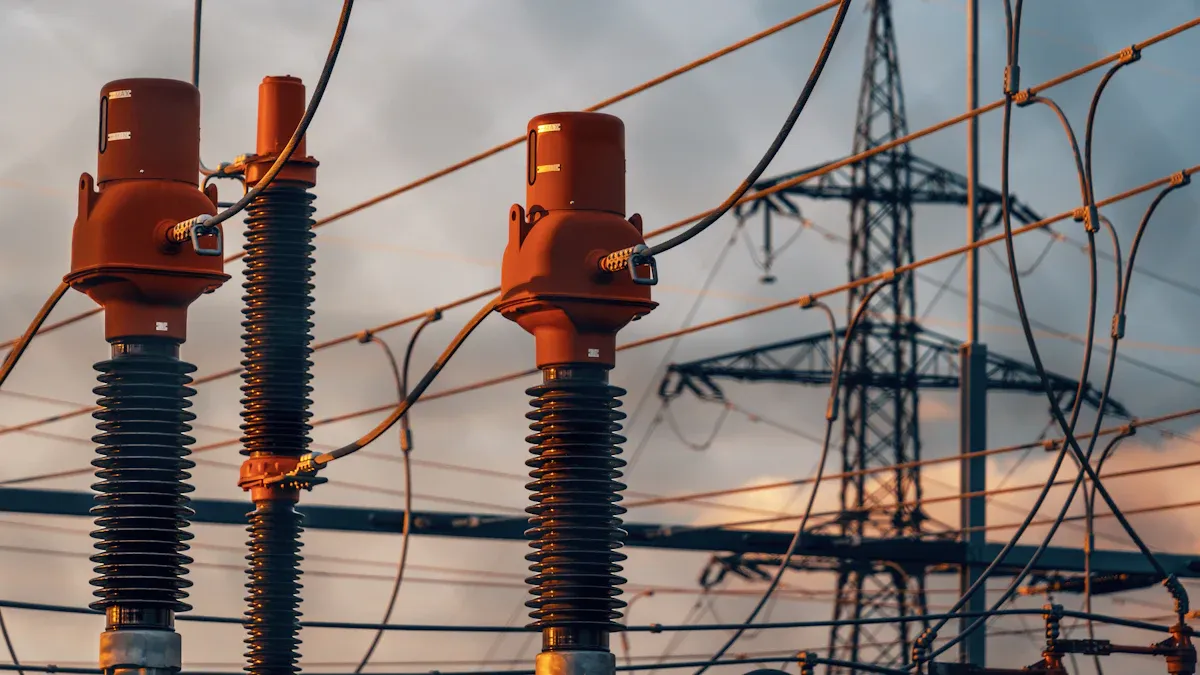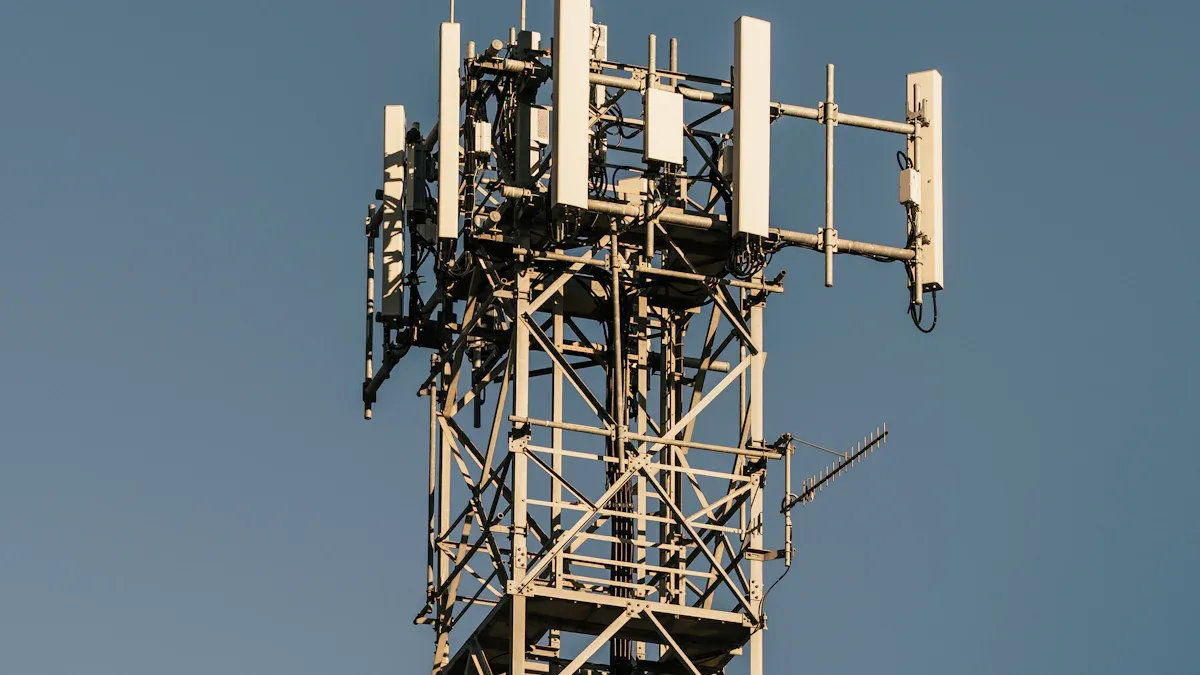How to Pick the Perfect Telecom Converter Rectifier

A telecom converter rectifier is essential for converting alternating current (AC) to direct current (DC), ensuring efficient power delivery to telecom systems. Choosing the appropriate telecom converter rectifier enhances reliability, minimizes energy loss, and reduces operational costs. Important factors to consider include voltage ratings, efficiency, and compatibility with the system. A properly selected telecom converter rectifier ensures smooth operations and adapts to changing requirements.
Key Takeaways
Pick a telecom rectifier that fits your system's voltage and current needs. This helps it work well and avoids damage.
Use energy-saving rectifiers to cut energy waste and save money. This is important for big telecom systems.
Think about future growth when choosing rectifiers. Modular designs let you add more power as networks grow.
Understanding Telecom Converter Rectifiers

What Is a Telecom Converter Rectifier?
A telecom converter rectifier is a device that converts alternating current (AC) into direct current (DC). This process ensures that telecom systems receive a stable and reliable power supply. These rectifiers are designed to meet the specific power requirements of telecom equipment, such as base stations and data centers. They play a critical role in maintaining uninterrupted communication services.
The technical specifications of telecom rectifiers highlight their efficiency and adaptability. For example:
Specification | Value |
|---|---|
Input Voltage (AC) | 220V AC or 380V AC |
Output Voltage (DC) | Typically 48V DC |
Efficiency | Up to 96% |
Power Consumption Increase | Almost 2x higher for 5G than 4G |
Maximum Output Voltage (Class 4) | Up to 450V DC |
Power Loss during Conversion | About 4% |
These specifications demonstrate the importance of selecting a rectifier that matches the system's power needs.
The Importance of AC to DC Conversion in Telecom Systems
AC to DC conversion is vital for telecom systems because most telecom equipment operates on DC power. This conversion ensures consistent performance and minimizes power loss. With the rise of 5G technology, the demand for efficient power supplies has increased significantly. Operating at higher voltages, such as high-voltage DC, enhances electrical efficiency and reduces energy waste.
Key benefits of effective AC to DC conversion include:
Stable and reliable network performance.
Reduced energy consumption and operational costs.
Enhanced efficiency by eliminating unnecessary power conversion stages.
These advantages make telecom converter rectifiers indispensable in modern telecom infrastructure.
Common Applications of Telecom Rectifiers
Telecom rectifiers are used in various applications to support communication networks. Their versatility and efficiency make them suitable for different scenarios. Some common applications include:
Application Type | Key Features |
|---|---|
5G Small Cells | High efficiency (99%), high power density (73 W/in³), designed for outdoor harsh environments. |
Base Stations | Utilizes advanced semiconductor technologies for efficient AC-DC power conversion. |
Totem-pole Power Factor Corrector | Hard switching configuration, operates at 65 kHz, designed for high reliability and efficiency. |
DC-DC Section | Uses LLC soft switching topology for improved performance in telecom applications. |
Bi-directional Capability | Reference designs available for telecom applications, ensuring continuous operation and longevity. |
These applications highlight the adaptability of telecom rectifiers in meeting the diverse needs of the telecom industry.
Key Factors for Choosing the Right Rectifier
Voltage and Current Ratings
Voltage and current ratings are critical when selecting a rectifier. These specifications determine whether the rectifier can handle the power demands of the telecom system. For example, a telecom converter rectifier designed for high-current applications must support sufficient output current to power all connected equipment. Undersized ratings can lead to system instability or even equipment failure.
To ensure proper rectifier selection, users should evaluate the input voltage range and the maximum output current. Matching these ratings with the system's requirements guarantees reliable operation. Additionally, considering future expansions can prevent the need for frequent upgrades.
Efficiency and Power Loss Considerations
Efficiency plays a significant role in reducing operational costs and energy consumption. High-efficiency power supplies minimize power loss during AC to DC conversion, which is especially important in large-scale telecom systems. A rectifier with an efficiency rating of 96% or higher can significantly lower energy waste, translating to cost savings over time.
Power loss during conversion is another factor to consider. For instance, a rectifier with a 4% power loss may seem negligible, but in high-demand systems, this can result in substantial energy waste. Selecting a rectifier with advanced rectifier technology ensures optimal performance and reduced energy loss.
Compatibility with System Requirements
Compatibility with existing telecom systems is essential for seamless integration. A rectifier must meet specific technical benchmarks and industry standards to function effectively. The following table outlines key compatibility standards:
Specification | Description |
|---|---|
Transient-Voltage Protection | EN61000-4-5 and EN41003 define pulse types that certified equipment must withstand. |
Electromagnetic Compatibility | EN55022 specifies maximum allowable amplitudes for EMI and RFI, along with compliance testing requirements. |
Safety Standards | EN60950 and UL950 define minimum isolation voltages and distances for telecom extra-low voltage outputs. |
These standards ensure that the rectifier operates safely and reliably within the telecom infrastructure. Verifying compliance with these benchmarks simplifies the selection process and enhances system performance.
Application-Specific Needs (e.g., indoor vs. outdoor use)
Different applications require rectifiers with specific features. For indoor use, compact designs with efficient cooling systems are ideal. Outdoor applications, on the other hand, demand robust rectifiers capable of withstanding harsh environmental conditions such as extreme temperatures, humidity, and dust.
For example, rectifiers used in 5G small cells often feature high power density and weatherproof enclosures. These characteristics ensure reliable operation in outdoor environments. Understanding the unique requirements of each application helps in choosing the most suitable rectifier.
Scalability and Future-Proofing
Scalability is a vital consideration for telecom systems that anticipate growth. Modular rectifiers offer flexibility by allowing users to add or remove modules based on changing power needs. This adaptability reduces the need for complete system overhauls, saving time and resources.
Future-proofing involves selecting rectifiers that can support emerging technologies like 5G and beyond. Investing in advanced rectifier technology ensures compatibility with future telecom standards and reduces the risk of obsolescence. By prioritizing scalability and future-proofing, telecom operators can maintain efficient and reliable systems over the long term.
Comparing Types and Models of Telecom Rectifiers
Overview of Common Rectifier Types
Telecom systems rely on various rectifier types to meet specific power conversion needs. Each type has unique operational principles and applications. Understanding these differences helps in selecting the most suitable rectifier for a given system.
Half-Wave Rectifiers:
These rectifiers convert only one half of the AC waveform into DC. They are simple in design and cost-effective but have lower efficiency due to significant power loss. Half-wave rectifiers are rarely used in high-performance telecom systems.Full-Wave Rectifiers:
Full-wave rectifiers utilize both halves of the AC waveform, resulting in higher efficiency and smoother DC output. They are commonly used in telecom applications where stable and reliable power is essential.Bridge Rectifiers:
Bridge rectifiers are a type of full-wave rectifier that uses four diodes arranged in a bridge configuration. This design allows for efficient AC to DC conversion without the need for a center-tapped transformer. Bridge rectifiers are widely used in telecom systems due to their high efficiency and compact size.Three-Phase Rectifiers:
These rectifiers are designed for three-phase AC power systems. They provide a more stable DC output with reduced ripple, making them ideal for high-power telecom applications like base stations and data centers.
Each rectifier type has its advantages and limitations. For example, bridge rectifiers are preferred for their efficiency, while three-phase rectifiers excel in high-power scenarios. Selecting the right type depends on the specific requirements of the telecom system.
Use Cases for Modular vs. Standalone Rectifiers
Rectifiers can be classified into modular and standalone designs. Each has distinct use cases based on system requirements and scalability.
Modular Rectifiers:
Modular rectifiers consist of multiple smaller units that can be added or removed as needed. This design offers flexibility and scalability, making it suitable for growing telecom networks. Modular rectifiers are often used in 5G infrastructure, where power demands may increase over time. Their plug-and-play nature simplifies maintenance and reduces downtime.Standalone Rectifiers:
Standalone rectifiers are single, self-contained units. They are ideal for applications with fixed power requirements, such as small telecom installations or backup power systems. Standalone rectifiers are typically more cost-effective for systems that do not require future expansion.
Choosing between modular and standalone rectifiers depends on factors like scalability, budget, and system complexity. Modular designs are better suited for dynamic environments, while standalone rectifiers work well in stable, predictable setups.
Evaluating Popular Models Based on Specifications
Selecting the right rectifier model involves evaluating key specifications to ensure compatibility and performance. The following table highlights important criteria for comparing rectifier models:
Key Factor | Description |
|---|---|
Voltage Rating | Ensure the rectifier can handle the peak AC voltage. |
Current Rating | Match the current rating with the application's requirements. |
Frequency | Verify compatibility with your circuit's operating frequency. |
Efficiency and Power Loss | Choose rectifiers with minimal losses for higher efficiency. |
Application-Specific Needs | Consider specific requirements such as full-wave or three-phase rectifiers for stability. |
For example, high-performance rectifiers designed for 5G applications often feature advanced technologies to minimize power loss and maximize efficiency. Bridge rectifiers are a popular choice due to their ability to handle high voltages and currents while maintaining compact dimensions. Three-phase rectifiers, on the other hand, are preferred for large-scale telecom systems requiring stable and efficient power delivery.
When comparing models, it is essential to consider both technical specifications and application-specific needs. This approach ensures that the selected rectifier meets current requirements while remaining adaptable to future demands.
Selecting the right telecom rectifier ensures efficiency and reliability while meeting future demands. The growing telecom power systems market, projected to reach $39.4 billion by 2033, highlights the need for scalable solutions. Aligning rectifier choices with long-term goals minimizes energy loss. Consulting experts or using manufacturer tools simplifies this critical decision-making process.
FAQ
What is the lifespan of a telecom converter rectifier?
Most telecom rectifiers last 10–15 years with proper maintenance. Environmental factors and usage intensity can impact their longevity.
How do modular rectifiers simplify maintenance?
Modular rectifiers allow quick replacement of faulty modules without shutting down the entire system. This reduces downtime and ensures continuous operation.
Can telecom rectifiers handle power surges?
Yes, most telecom rectifiers include transient-voltage protection. This feature safeguards equipment from power surges, ensuring reliable performance.
See Also
Ensuring Consistent Power Supply For Telecom Equipment
An Introductory Overview Of Telecom Power Supply Systems
Essential Features Of Telecom Power Supply Systems Explained
CALL US DIRECTLY
86-13752765943
3A-8, SHUIWAN 1979 SQUARE (PHASE II), NO.111, TAIZI ROAD,SHUIWAN COMMUNITY, ZHAOSHANG STREET, NANSHAN DISTRICT, SHENZHEN, GUANGDONG, CHINA
